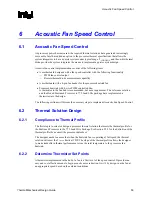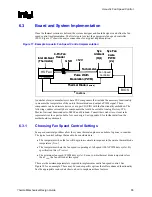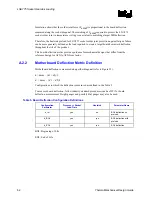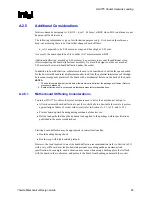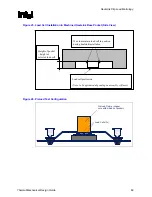
LGA775 Socket Heatsink Loading
R
Thermal/Mechanical Design Guide
65
A.2.5 Additional
Considerations
Intel recommends designing to {d_BOL – d_ref = 0.15mm} at BOL when EOL conditions are not
known or difficult to assess.
The following information is given for illustration purposes only. It is based on the reference
keep-out, assuming there is no fixture that changes board stiffness:
d_ref is expected to be 0.18 mm on average, and be as high as 0.22 mm.
As a result, the board should be able to deflect 0.37 mm minimum at BOL.
Additional deflection, as much as 0.09 mm may be necessary to account for additional creep
effects impacting the board/clip/fastener assembly. As a result, designs could see as much as
0.50 mm total downward board deflection under the socket.
In addition to board deflection, other elements need to be considered to define the space needed
for the downward board total displacement under load, like the potential interference of through-
hole mount component pin tails of the board with a mechanical fixture on the back of the board.
NOTES:
1. The heatsink preload must remain below the maximum load limit of the package at all times (Refer to
processor datasheet).
2. Board deflection should not exceed motherboard manufacturer specifications.
A.2.5.1
Motherboard Stiffening Considerations
To protect LGA775 socket solder joint, designers need to drive their mechanical design to:
•
Allow downward board deflection to put the socket balls in a desirable force state to protect
against fatigue failure of socket solder joint (refer to Sections A.2.1, A.2.2, and A.2.3).
•
Prevent board upward bending during mechanical shock event.
•
Define load paths that keep the dynamic load applied to the package within specifications
published in the processor datasheet.
Limiting board deflection may be appropriate in some situations like:
•
Board bending during shock.
•
Board creep with high heatsink preload.
However, the load required to meet the board deflection recommendation (refer to Section A.2.3)
with a very stiff board may lead to heatsink preloads exceeding package maximum load
specification. For example, such a situation may occur when using a backing plate that is flush
with the board in the socket area, and prevents the board from bending underneath the socket.
Содержание 640 - Pentium 4 640 3.2GHz 800MHz 2MB Socket 775 CPU
Страница 14: ...Introduction R 14 Thermal Mechanical Design Guide ...
Страница 38: ...Thermal Management Logic and Thermal Monitor Feature R 38 Thermal Mechanical Design Guide ...
Страница 52: ...Intel Thermal Mechanical Reference Design Information R 52 Thermal Mechanical Design Guide ...
Страница 60: ...Acoustic Fan Speed Control R 60 Thermal Mechanical Design Guide ...
Страница 72: ...Heatsink Clip Load Metrology R 72 Thermal Mechanical Design Guide ...
Страница 97: ...Mechanical Drawings R Thermal Mechanical Design Guide 97 Figure 48 Reference Clip Drawings Sheet 1 ...
Страница 98: ...Mechanical Drawings R 98 Thermal Mechanical Design Guide Figure 49 Reference Clip Drawings Sheet 2 ...
Страница 99: ...Mechanical Drawings R Thermal Mechanical Design Guide 99 Figure 50 Reference Fastener Sheet 1 ...
Страница 100: ...Mechanical Drawings R 100 Thermal Mechanical Design Guide Figure 51 Reference Fastener Sheet 2 ...
Страница 101: ...Mechanical Drawings R Thermal Mechanical Design Guide 101 Figure 52 Reference Fastener Sheet 3 ...
Страница 102: ...Mechanical Drawings R 102 Thermal Mechanical Design Guide Figure 53 Reference Fastener Sheet 4 ...
Страница 103: ...Mechanical Drawings R Thermal Mechanical Design Guide 103 Figure 54 Clip Heatsink Assembly ...
Страница 104: ...Mechanical Drawings R 104 Thermal Mechanical Design Guide Figure 55 Intel R RCBFH 3 Reference Solution Assembly ...



